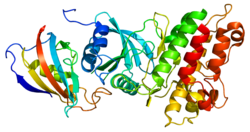Activin A receptor, type I (ACVR1) is a protein which in humans is encoded by the ACVR1 gene; also known as ALK-2 (activin receptor-like kinase-2).[5] ACVR1 has been linked to the 2q23-24 region of the genome.[6] This protein is important in the bone morphogenic protein (BMP) pathway which is responsible for the development and repair of the skeletal system. While knock-out models with this gene are in progress, the ACVR1 gene has been connected to fibrodysplasia ossificans progressiva, an extremely rare progressive genetic disease characterized by heterotopic ossification of muscles, tendons and ligaments.[7] It is a bone morphogenetic protein receptor, type 1.
- ^ a b c GRCh38: Ensembl release 89: ENSG00000115170 – Ensembl, May 2017
- ^ a b c GRCm38: Ensembl release 89: ENSMUSG00000026836 – Ensembl, May 2017
- ^ "Human PubMed Reference:". National Center for Biotechnology Information, U.S. National Library of Medicine.
- ^ "Mouse PubMed Reference:". National Center for Biotechnology Information, U.S. National Library of Medicine.
- ^ ten Dijke P, Ichijo H, Franzén P, Schulz P, Saras J, Toyoshima H, Heldin CH, Miyazono K (October 1993). "Activin receptor-like kinases: a novel subclass of cell-surface receptors with predicted serine/threonine kinase activity". Oncogene. 8 (10): 2879–87. PMID 8397373.
- ^ Pignolo RJ, Shore EM, Kaplan FS (June 2013). "Fibrodysplasia ossificans progressiva: diagnosis, management, and therapeutic horizons". Pediatr Endocrinol Rev. 10 Suppl 2 (2): 437–48. PMC 3995352. PMID 23858627.
- ^ de Ruiter RD, Smilde BJ, Pals G, Bravenboer N, Knaus P, Schoenmaker T, et al. (2021). "Fibrodysplasia Ossificans Progressiva: What Have We Achieved and Where Are We Now? Follow-up to the 2015 Lorentz Workshop". Front Endocrinol (Lausanne). 12: 732728. doi:10.3389/fendo.2021.732728. PMC 8631510. PMID 34858325.
© MMXXIII Rich X Search. We shall prevail. All rights reserved. Rich X Search





